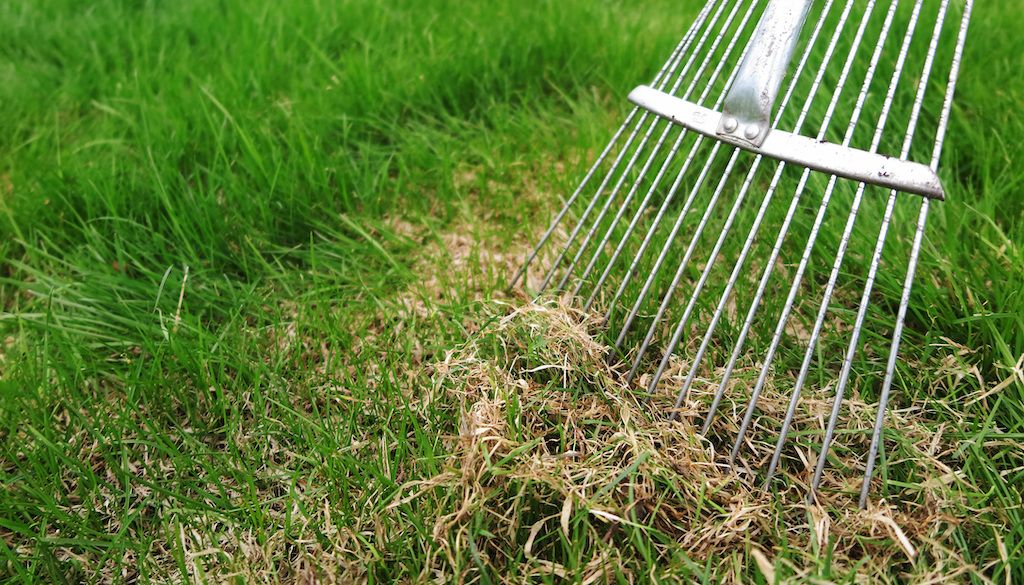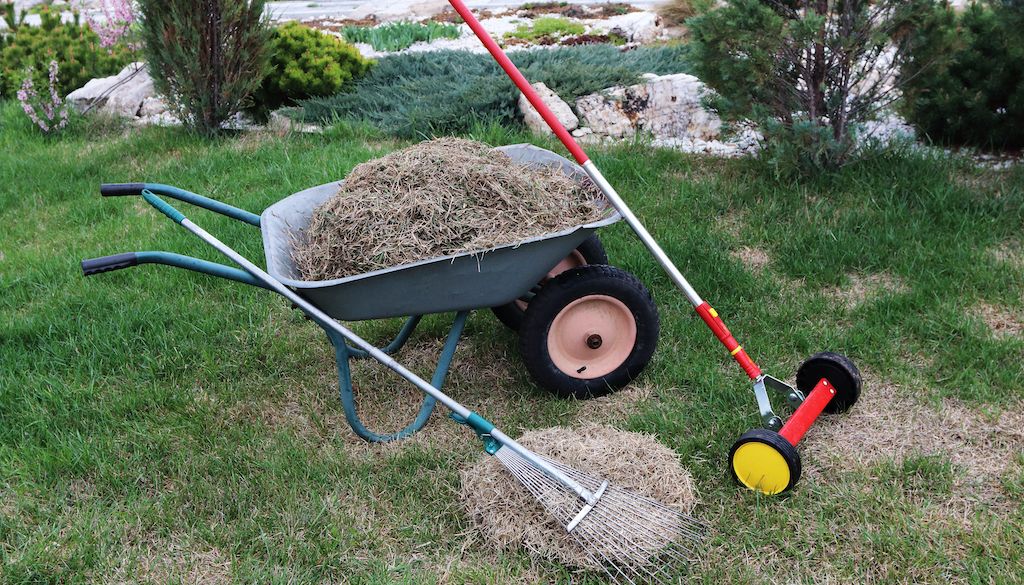What is thatch?
Thatch is the layer of organic matter between a compacted soil and root system and the grass blades. It consists of both living and dead tissue and may include byproducts from roots, stems, leaf sheaths and crowns.
Your lawn may start to accumulate thatch if you over-fertilize or over-water it. Soil compaction can also lead to more thatch. Proper fertilization, aeration, irrigation and mowing techniques can help prevent thatch buildup.
Pros and cons of having thatch on your lawn.
Ideally, your grass will benefit from a minimal amount of thatch. An acceptable layer of thatch, around 1/2 inch or less, can cushion the soil surface and moderate soil temperature fluctuations. A healthy amount of thatch can also prevent frost damage, limit weed growth and reduce water evaporation.
Too much thatch, however, can become a breeding ground for pests and insects. It can prevent water and important nutrient materials from reaching the soil. This can lead to problems like drought stress, fungal growth and reduced root growth.
Like many problems, prevention is the easiest way to control thatch. But when thatch has grown to excessive levels, you can use lawn dethatching techniques to get rid of it.
Related: Pros and cons of dethatching lawns.
Why is lawn dethatching important?
Too much thatch creates a problematic barrier. It could block the nutrients your grass and soil need to survive.
Thatch can decompose on its own, which is why half an inch or less is a manageable amount. But when thatch growth exceeds its decomposition rate, dethatching your lawn can help restore it to healthy levels.
Excess thatch can lead to problems like:
- Water and air movement interference
- Reduced pesticide and fertilizer response
- Increased insect and disease activity
If it’s already grown to excess levels, you can use techniques for how to dethatch the lawn yourself. Or, hire a lawn dethatching professional to complete the job.
How do I know if my lawn needs dethatching?
You may be able to tell your lawn needs dethatching from the feeling of walking on it. If the grass blades feel spongy when you walk on them, it may be time to dethatch.
To confirm dethatching is necessary, remove about a pie-sized sample of the lawn to a depth of around 3 inches. Measure the brown layer between the soil’s surface and the grass blades to determine the thatch length. If the thatch exceeds half an inch, it’s best to dethatch to prevent problems.
When and how often should I dethatch my lawn?
The amount of dethatching a lawn requires depends on its unique type. According to Purdue Extension and the University of Illinois Extension, perennial ryegrass and tall fescue rarely need dethatching. That's because they have a bunch-type growth habit.
For grasses that require dethatching, it’s best to do it during their active growth periods so they can recover quickly. Warm-season grasses like zoysia grass should be dethatched in the early summer. Cool-season grasses like Kentucky bluegrass should be dethatched in the spring or during early fall lawn care.
How to dethatch your lawn.
If you've determined it's time to dethatch your lawn, we'll walk you through the steps. But first, make sure you have everything you'll need.
The tool(s) you’ll need for lawn dethatching will depend on your lawn's size and how intense the job is. Typical dethatching tools include:
- Thatching rake: You can use a dethatching rake, sometimes called a power rake, to dethatch small lawns. A dethatching rake has thick blades that can loosen up the thatch.
- Vertical mower: You can use a vertical mower, sometimes called a verticutter, to mow large lawns. Vertical mowers have a series of revolving blades that cut through the thatch and loosen it up to the surface.
- Rake and trash bin. You'll also need tools to collect thatch debris, like a rake and bin for disposal.
Step 1: Rake or mow the lawn.
 If you're using a dethatching rake, drag it across your lawn. This will bring the thatch up to the soil's surface.
If you're using a dethatching rake, drag it across your lawn. This will bring the thatch up to the soil's surface.
If you’re using a vertical mower, adjust the blade height based on the thatch thickness. Run the mower across the lawn in one direction. Once the entire lawn has been dethatched, mow the lawn again at an angle perpendicular to the first mow.
Step 2: Remove and discard the thatch debris.
 Use a rake to remove the debris, put it in a bag or wheelbarrow, and discard the material. You don't necessarily have to throw it away, however. For example, you can:
Use a rake to remove the debris, put it in a bag or wheelbarrow, and discard the material. You don't necessarily have to throw it away, however. For example, you can:
- Use it as mulch.
- Bring it to a county compost site.
- Add it to your own at-home compost bin.
Step 3: Aerate, fertilize, water and overseed as needed.
 Once you’ve dethatched and discarded the debris, determine if you need to aerate, fertilize, water and overseed your lawn. Follow the directions on the packaging carefully. And remember: over-fertilizing and over-watering your lawn could lead to too much thatch.
Once you’ve dethatched and discarded the debris, determine if you need to aerate, fertilize, water and overseed your lawn. Follow the directions on the packaging carefully. And remember: over-fertilizing and over-watering your lawn could lead to too much thatch.
Related: How long should you water your lawn?
Lawn dethatching mistakes to avoid.
When dethatching, avoid the following mistakes:
- Avoid dethatching when weeds are germinating so they don’t spread throughout your grass.
- Don't apply pre-emergence herbicides before dethatching. This can cause them to bind with the thatch and become less effective. Instead, apply them after dethatching.
- Don’t aerate and fertilize before dethatching. Do these steps afterward.
- Avoid using “power rake” attachments on rotary mowers for dethatching. The University of Minnesota Extension reports these can destroy existing grass and aren’t effective for removing thatch.
Hire a lawn dethatching service on Thumbtack.
Lawn dethatching helps you maintain a healthy lawn. But doing it at the wrong time or with the wrong tools could cause more problems.
A lawn care professional can help you. They can determine the best time for dethatching, and help you prepare the grass. They can also make sure the right tools are used in order to minimize lawn damage.
Download the Thumbtack app today, and start getting estimates from top-rated lawn care pros near you.
Related: How much do lawn care services cost?
FAQs
What is the best month to dethatch your lawn?
The best time to dethatch your lawn depends on the type of grass you have. The best time to dethatch a lawn is during its peak growing season. So, it's best to dethatch warm-season grasses in the late spring or early summer. Dethatch cool-season grasses in early spring or early fall.
How long does it take for a lawn to recover from dethatching?
When you dethatch a lawn during its active growing season, the grass usually recovers quickly from dethatching. The recovery period typically lasts around three to four weeks.
Is thatching or aerating better?
Aerating soil helps prevent thatch buildup since the process promotes air and moisture penetration that facilitates drainage. Aeration also helps cultivate healthier root systems and facilitates thatch decomposition.
Once thatch exceeds half an inch in depth, you should thatch your lawn, then aerate it to prevent future excess thatching.
A note about project costs included or linked in this article: Figures represent national average cost estimates using data provided by Thumbtack pros and additional research. These figures are provided for educational purposes only and are subject to change at any time due to various factors. Details about your specific project and local rates can impact costs.